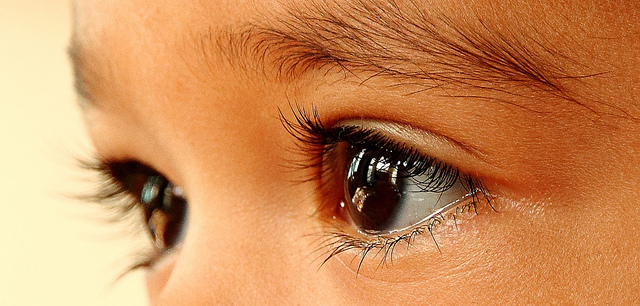 Health & Physiology
Health & Physiology
A novel treatment for inherited blinding eye diseases
The innovative molecular technique known as CRISPR/Cas9 opens new landscapes for treating genetic disorders otherwise incurable.

The cornea is the window at the front of the eye through which light passes allowing us to see clearly. Corneal dystrophies, which cause a loss of this essential transparency, are a group of inherited blinding eye diseases for which there is no cure. They worsen through life until sight is lost. Medical care at most will address discomfort and pain but the only treatment option available is corneal transplant offered only when vision is almost lost. Transplant surgery often fails due to recurrence of the disease.
Our group at Ulster University in Northern Ireland, is developing a new approach to treating these diseases before sight is lost using a novel gene-editing technology to correct the mistake in the DNA of the patient's eye cells.
DNA can be imagined as a long strand of information coded by a language made of 4 letters (called nucleotides). Information is stored within stretches of DNA called "genes" which are composed by a precise sequence of these "letters". Patients with these type of inherited diseases often only have one single letter mistake in one copy of one of their 25,000 genes. Remember that we get one gene from Mum and one from Dad. The gene from one parent works perfectly well, but, in this case, the damaged copy coming from the other parent takes priority over the normal copy, it dominates. These types of diseases are referred to as dominantly inherited diseases and they can affect various parts of the body, not just our eyes.
Through our research, our aim is to remove the damaged copy, leaving only the normal copy, hence restoring vision in these patients. The same approach, once developed, can be applied to other diseases with similar dominant inheritance pattern such as Huntington's disease and neurofibromatosis.
We do this using an exciting molecular tool, known as CRISPR/Cas9, which makes gene editing a real achievement in the clinic. CRISPR/Cas9 acts like a pair of molecular scissors that can be guided very precisely to cut at the exact place in all the 3 billion letters that make up the DNA in our cells.
To do so, engineered CRISPR/Cas9 protein works its way along the DNA molecules, scanning until it finds a short 3 letter signal sequence that it must bind to. It then looks at adjacent 18-20 letters to see whether they match the sequence that you have given it to look for. If the CRISPR/Cas9 protein i) finds the correct 3 letter signal and ii) finds the matching adjacent sequence, then the molecular scissors will cut the DNA - in our case the bad gene.
We have been able to utilize this system to direct the molecular scissors to cut the gene responsible for a patients' corneal dystrophy. Whilst doing this, we had to make sure that the scissors only cut the gene with the mistake and leave the good gene uncut.
For the majority of corneal dystrophies, the only difference between the damaged and working copy of the gene is a single letter. PhD Researcher Kathleen Christie has performed experiments to investigate whether CRISPR/Cas9 could tell the difference between the damaged and the good gene and assessed if this single letter change could be more efficiently found in i) the 3 letter signal motif or ii) the 18-20 letter guide supplied to the molecular scissors.
Interestingly we found that if the single letter change was present in the 18-20 letter guide supplied to the molecular scissors, their gene therapy treatment was not able to discriminate between the damaged and undamaged copies of the gene - therefore could never translate to the clinic. However, if the single letter change, the disease-causing mutation, was present in the 3 letter signal detected by the molecular scissors then a complete discrimination was achievable.
Since not all disease-causing DNA damage will have the change of letter present in a signal motif, their current research involves expanding this approach to ensure targeting of the damaged copy in every case. This novel gene-editing approach offers a single, permanent treatment option that will restore vision in these patients and, importantly, our research teams are the first to obtain proof of concept in living animals.
Original Article:
Christie K, Courtney D, DeDionisio L, Shern C, De Majumdar S, Mairs L, Nesbit M, Moore C. Towards personalised allele-specific CRISPR gene editing to treat autosomal dominant disorders. Sci Rep. 2017;7(1). doi:10.1038/s41598-017-16279-4.Edited by:
Massimo Caine , Founder and Director
We thought you might like
A new code for a new life
May 26, 2016 in Maths, Physics & Chemistry | 3.5 min read by Jordan CostafrolazLego blocks for precise gene editing
Feb 6, 2018 in Health & Physiology | 4 min read by Jared Carlson-StevermerEngineering bacteria to save honey bees
Feb 11, 2021 in Microbiology | 3.5 min read by Sean Leonard , Nancy MoranMore from Health & Physiology
Chemotherapy and heart failure
Mar 25, 2024 in Health & Physiology | 2.5 min read by Hector Villarraga , Mariana Garcia ArangoStressing the gut-brain axis
Jan 29, 2024 in Health & Physiology | 3.5 min read by Niklas Blank , Kai Markus Schneider , Christoph ThaissTaurine: a supplement for extending life-span and health
Jan 24, 2024 in Health & Physiology | 3 min read by Vijay Kumar Yadav , Parminder Singh , Kishore GollapalliTake Them Outside: Cold Air Helps Croup Symptoms in Kids
Jan 3, 2024 in Health & Physiology | 3.5 min read by Zoé ValbretHow the immune response to a common virus may target the brain in multiple sclerosis
Dec 20, 2023 in Health & Physiology | 4 min read by Olivia ThomasEditor's picks
Trending now
Popular topics


